Click here for the article. For access to the full feature article you must sign up (free for the first two weeks). Enjoy with a cup of tea and a lick of salt.
Click here for the article. For access to the full feature article you must sign up (free for the first two weeks). Enjoy with a cup of tea and a lick of salt.
A yellow bolt of colour blazes from just outside of the hut. Drying kernels of corn create a carpet of bright yellow. Lean mountain chickens make haste to strut into the shaded areas and a family dog looks to have given up entirely even trying to look as though he can guard in this ferocious heat.
I am crunched down upon a tiny rattan stool with in a sleepy dark room. On the concrete floor before me there are embers that smoke and crack. The fire’s strength is long gone, and the hanging kettle above it looks satisfied letting out only a wisp of steam.
My clothes are matted to my body, soaked. Sweat has covered me since dawn broke at six-thirty. The humid heat is eating away at what little bits of brain are in fact functioning, but at least tea has been consumed – loads of tea. Tea’s ‘cooling’ effect, long known to many indigenous is one of its least touted benefits. Tea in various forms has been used as a veritable cure-all: anti-inflammatory agent, anti-viral, and fever-buster by the Hani, Pulang, Lahu and Dai peoples. I’m not at all certain though that tea has cooled me in the least.
This morning, it serves only to stimulate my aching body and wake me up. For three hours I have been throwing back cup after cup of it while listening to the tiny village of Ban Po struggle into a new day.
Nannuo Mountain(s) lies along the sleepy eastbound route from Jinghong to Menghai. Rising up from both sides of the paved shoulders in ever increasing heights it seems spliced in half, cleaved by an offending paved road. Stronghold of the animistic Hani people, the mountains have hosted tea harvesting for a thousand years or more and as with any ‘tea mountain’ there are good, bad, ugly and sad end results.
My hostess knows me and my thirsts well. Pai has long been feeding my tea needs and her family’s tiny home is inundated with plastic bags of tea sitting in reckless heaps in every possible corner. Here in her village, like hundreds throughout this steamy part of Yunnan, tea is all. Fortunes, moods and taste buds rise and fall with each successive harvest of green.
I have been snorting back newly picked tea from ancient tea trees. This doesn’t qualify as ‘old tea’ (lau cha), which has become such a trendy item in recent years. This tea does qualify, in my eyes at least, as a genuine quality tea. Unsprayed, easier on an empty stomach and a much less astringent taste make these teas precious (and more expensive) to those who have been smitten by them.
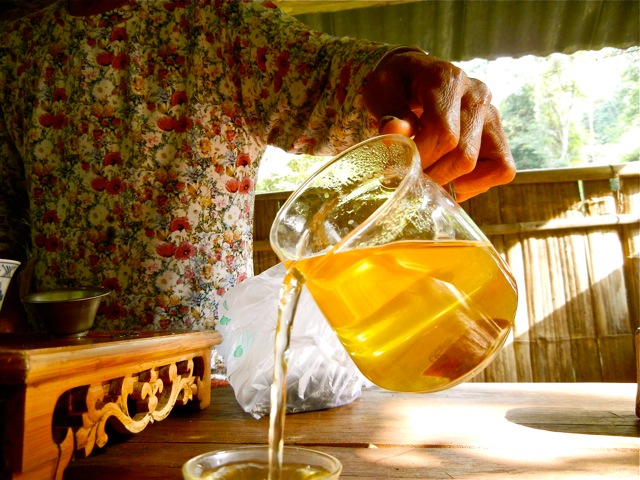
Panacea for all things, the offer of tea and the cup itself is one of the rewards for the journey to any tea sanctuary
Fortunately (or unfortunately depending on who has been touched by these classics) these teas are rare and to complicate the matter, rarer still due to the sacrilegious legions of ‘fake’ old tea tree tea touted on domestic markets.
Pai and her home emanate a deep silence and it seems that anything beyond a murmur will shatter this tea sanctum. Pai herself is ghosting around through beams of sunlight that cut through the wooden walls.
As with all things tea in life, one must go to the source, (if at all possible) to ensure that one does in fact get to sample something of the divine. And so, I have returned again to Nannuo Mountain, not only to debauch on amounts consumed but also to access the forests – the ancient tea forests – that provide this nectar.
With my tea need temporarily sated, and Pai eager to move before the heat notches up yet again, we head south and up along paths that have been worn by a thousand seasons of harvester’s feet.
Valleys give way to lush damp forests that swelter. Harvesters avoid the mid-day sun, preferring the silent mornings when the sun’s rays have yet to stimulate the tea leaves’ delicate pigments. Pai is singing and humming along, often pointing out a path she used as a child to access a particular tea patch. Cicadas and their eerie songs and the odd ‘hoo-hooing’ of monkeys create a soundtrack of the rippling green forests.
The day is windless and smells at times of rotting fruit as papaya, banana and other sub-tropical trees spill their ripe goods onto the furnace floor of forest. Rows of neat tea bushes, some only a couple of years old stand in a rigid kind of anarchy, like slightly misbehaving statues. After less than forty minutes though, we are following a ragged pathway that wanders up in right angle switchbacks. We are heading into the ‘gu shu’ (ancient trees) part of the mountains.
Looking up from the maze of a pathway I look up at a forest that has changed its shape. Gone are the razor straight bamboo trees with their geometric appeal. What has taken over the quiet forest are muscular shaped trees that seem ungainly and stoic with large green leaves tapering their ends…tea leaves. A suitable hush ensues, where sounds have all muffled. Tea and its ancient force are the lords of the space.
Pai, walks with the kind of resigned ease of a local, and tells me that these ‘youthful’ specimens are ‘only’ a few hundred years old, even though they would (and do) qualify as ancient. Nannuo Mountain is more a series of mountains, hills and villages covering a huge area than a single bulky form. Teas from Nannuo Mountain are as varied as teas from entirely different regions, counties and prefectures are. Picking and harvesting a tea is one thing, production and post-picking treatment another. In order that a tea reaches its potential weather, harvester and producer all must be in concert.
What the buyer/seller/addict will look for and what locals will tell one to look for in an ancient tree’s tea is (for better or worse) a taste and aftertaste that is distinct and unambiguous, a taste that comes in waves and levels and never stops. Ancient tree tea will usually lack some of the potent bitter blast of a new Spring harvest, but will have a long finish with hints of what the deep root system pick up from the earth.
Tea tree roots do not spread wide but rather drive deep into the earth in a never ending plunge seeking out nutrients, and roots of an ancient tea tree can go where few other roots can.
While classic Nannuo teas like ‘Bang Ma’ and ‘Pa San’ will be coveted by drinkers of raw green Puer, a tea designated “Ancient Tea Tree” (gu shu cha), will always appeal regardless of price or source.
Stopping amid the forest Pai and I are wrapped within a sanctum of green as raw and wild as any I have seen. There is no symmetry, no regimented lines – it is the natural world’s brilliant chaos. Hulking shapes that are both archaic and understated; I stand within a world of ancient tea trees that give no hint of their abilities to conjure up a gorgeous cup of fluid.
This journey has taken us to an epicenter where few if any of man’s interferences exist. Harvesting hasn’t changed and for now at least, harvesting is still only done three times a year particularly with the ancient tree’s leaves. Small pathways lead from this forest to any number of communities tucked away. These tea forests are ‘owned’ and designated by acceptance only. There are no fences, no signs designating anything even remotely unnatural. Respect and understanding of tea’s meaning (and worth) within the communities is paramount and evidently here, still enough. The traditional ‘rules’ of verbal transmission and honour, refreshingly still mean something.
Pai leads further up still, to a point where the trickling of a stream tinkles through the air. Beside this spring-fed stream, a small fire crackles and a split log acts as a tea table. A tiny woman with strong dark features bids us to sit flashing us a wordless smile when I ask what is on the menu…she simply points a finger to the aged trees around us. Pai tells me that much of the surrounding forest is owned by her family and this little rest stop is a place that harvesters often come for their own jolt of ‘green’.
The tea that we finally sip – which is prepared without fuss or drawn out explanations of the qualities or flavours – runs through the mouth clean, lighting up the back of the mouth. The flavours last and infuse an earthy green into the sinuses. There is no need to talk of tastes, no need to impress. Here the tea is stunning and there is no reason to bluster on about it. It is often this way within the planet’s great centres of tea production – the better the tea, the less the fuss.
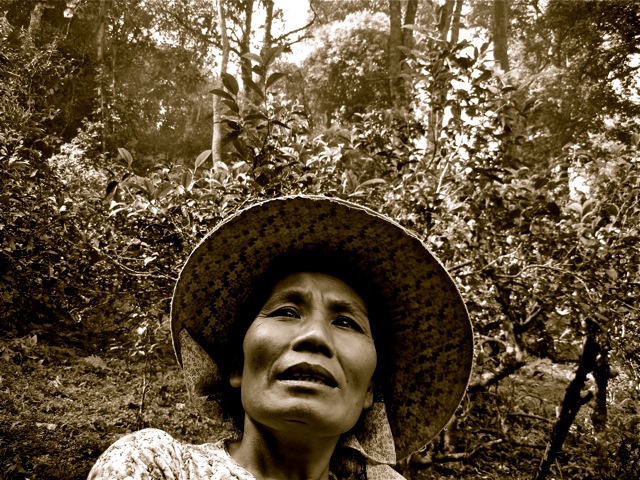
Like many of Asia's ancient traditions and secrets, tea's great tales rest in the minds and tales of elders
Walking down the mountain later in the day, Pai inadvertently (or perhaps very purposefully) states why the teas here are so coveted, so special, “they [the trees] are part of our community, like family”.
Interview with Jeff Fuchs on EZ in the City
Upcoming talk at Museum of Nature in Ottawa Canada on the importance of trade and Puer in the Himalayas.
Looking at the sky we see fierce white monotones and wind’s power, below in front of us on the earth lies a different story.
An avalanche’s disintegrating power has rearranged the land in front of us. A brutal black surge of turned earth, stones and newly formed shaped forms that stretch kilometres across the valley.
It has only served to enhance in many ways an already formidable scene. Five years earlier Amne Machin released a colossal chunk of itself upon the land below and we are now grinding our way over this ‘reconstructed’ surface.
We, for the first time on this portion of our journey, are steadily descending and with this knowledge comes an exhausted nostalgia and a twinge of sadness – we are exiting the main protective body of the Amne Machin range which fades to our right. ‘Civilization’ is coming closer step by step, though admittedly we still have much distance to cover…Michael is feeling this glumness as well. I am doing everything in my limited mental powers to stay in each progressive moment and not to let the mind jump ahead out of the now. I keep wondering at how we came to this point, where we are about to end….
After packing up our camp for the last time there is a simmering of finality.
One of the more masochistic pleasures of expeditions within mountain abodes is that after a time the harsh beauties of the elements reconfigure the body and mindscape and everything in its simple way works. A groove is reached where one can continue indefinitely and this is only enhanced when travel partners are on that similar thread of ability and thought. Michael in his month along this journey has gone from a precisely trained endurance athlete to something more akin to a ‘grinder’. These elements, at these altitudes necessitate a test of the self more completely than any other – this is of course my very bias touch here. In the words of a nomad, “mountains draw the self out”.
Descents are most often when the body’s subtle complaints remind one that they do exist. The charge and blood inducing high of ascending has passed and now the earth and all of its trials and menial concerns beckon one back inevitably. Yes, mountains are an escape, but they are an escape that hit one’s morphology, one’s psychology and that nameless thing in the body that sings of something divine. It is something beyond, right here on earth.
The yaks seem impatient to get home pushing ahead, as strong and steady as ever. Peaks become rounded hills, and the snowline dissipates as we continue. We are descending through a valley that splits the highlands and even the air around us is somehow diminishing in power.
Along a frozen river we tread, heading directly northwest now, metres of thick ice under our feet. A small batch of winter mud huts rest along the river’s watershed edge and pockets of life are springing up. I am almost dreading the return…it is the normal feeling for me, as I view this more as a departure than an arrival – a departure from the fortifying gifts of the mountains.
Our little terrier’s energy, however, has not for a moment diminished on the entire journey, with his nose dominating all he does. He is no doubt considering the meals and bit of rest and relaxation that he will be taking in.
Gamzon, our champion of silent competence is unchanged as well, but tells us that we will stop for tea at her sister’s home. Her voice leaves no room to question the wisdom; it is as close to an order as she has ever uttered to us.
Michael and his dark beard of red is starting to look the part of a ruffian and indeed our whole unit has taken on a competency and understanding of eachother…as well as a battle ready countenance.
Breaking through a valley we come upon our old friend the Nam River – surely the dilapidated town of Xiadawu, where we began this week long circumnavigation of Amne Machin, cannot be far. It isn’t.
Gamzon and the yaks cross the ice-cold river and Michael and I must cross the thigh deep flow carefully. Our feet take only a minute to dry in the wind and sunbeams.
Coming up out of the valley we catch a glimpse of the town and it sinks in that this is the end, for now.
Sitting in a neat and tidy home thirty minutes later, Michael and I sit opposite one another with a table of biscuits, homemade bread and sweets between us. For the first time in a week we are holding glass mugs again, rather than our ‘do-it-all’ bowls.
We are both silent, and I feel in me a longing to bolt back into the mountains’ sanctity. A last night spent in the village with locals and a huge meal….tomorrow begins for us the slow and inevitable return to the provincial capital of Xining and a number of thermoses of tea to throw back, just to stay sane.
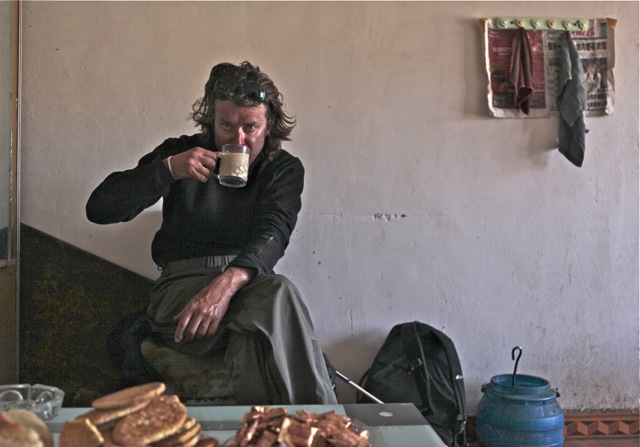
Jeffers trying very hard to remain seated indoors...the urge to bolt was only kept down by the mug of tea in hand
Thanks for following along and hope we were able to provide a little hint of colour to the fabled tsa’lam, the route of salt. I will be posting information about upcoming articles about this expedition in select publications as they become available. More tea and mountain blogs to follow as ultimately, this still remains a site for Asia’s ancient fluid and the peaks.
Jeff
We are moving higher yet – moving into ‘higher than highlands’ on a sheet of ice that is perhaps 2 km’s wide. It blankets the valley with its wide, white grace giving the landscape a clean and almost clinical beauty. Winds run wild, streaking happily across these worn down valleys picking up minute shards of ice and snow and hurtling them around.
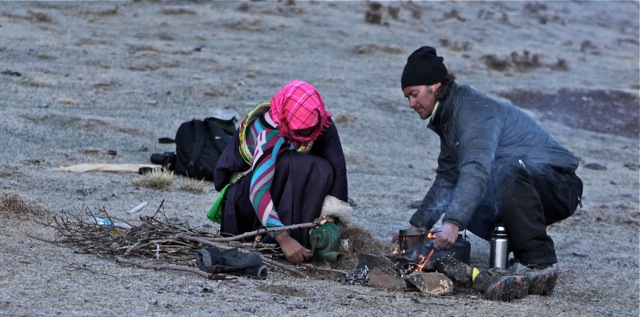
Fire upon the frozen earth is the first priority of our day – followed by tea, footwear-warming and then a thawing out of the bones
Nighttime temps plunged the night before and even fast rushing glacial streams are in the midst of thawing themselves out in the punishing neema (sun). We are making our way through the Aron Mu valley with the Aron Mu River slicing beneath the ice we are now treading upon.
It is a day of plodding and grinding with real distances and our impressions of how much terrain we are covering being at odds. In these vast spaces judging distances has become a daily deception. Following Gamzon’s rough pattern over the ice as she plods along the path it is obvious that she ‘knows’ not only the route, but the nature of the route. She is choosing the path with the least risk of plunging through crevasse or ‘hole’. The yak seem to ‘smell’ or sense intuitively the portions of disguised ice to avoid. At one point the yaks, who are leading, swivel their powerful frames left and circle a portion of ice for no apparent reason. As I pass over the portion they’ve steered clear of my walking stick plunges into to a mini abyss that spirals metres down.
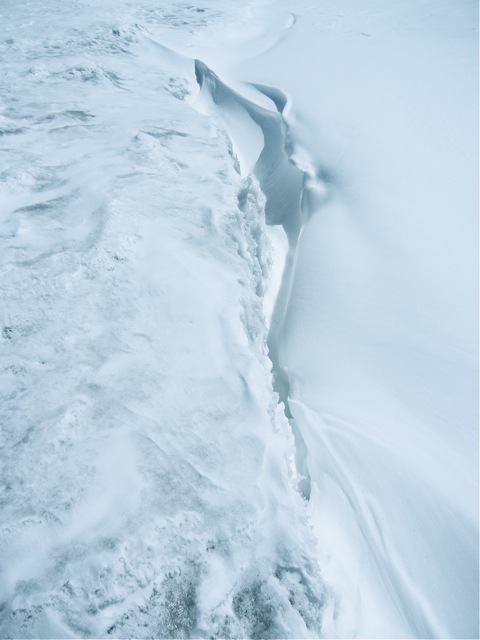
Windblown snow and ice that cover perils in the form of ‘tunnels’ and holes that often plunge metres into mini-chasms
Mountain-‘scapes’ have always held the power to impose themselves upon the will, burrowing into the psyche with power and just a tinge of the ominous. Punishing and soothing, these spartan heights have their own soundtracks and have that rare ability to provide an environment by which to edit the mind’s errant wanderings. Mountains can still the mind like few other places.
We once again pass the 4,500 metre barrier. Our days have at times been an unending series of ascents and dips – climbing up only to descend around the next desolate bend. It is in this way the land dictates the pace entirely.
A laser-like sun is bouncing off of the ice, ratcheting up the heat. We haven’t seen the colour green in a week – all that we have seen is coming out of its dry winter shell.
The grinding of our past days has taken relatively minor tolls on us. Michael’s feet are in dire condition, though, with his nails falling off in his socks and an entire layer of his sole slowly peeling off, but he has been powering through the constant discomfiture with stoic tenacity. It is only one night when I see the extent of surface damage that I marvel.
My single ailment was ‘received’ this morning while loading the yak. My four-legged friend twice cracked the identical spot of my left ankle within four minutes with a solid blow from a hoof. They were shuddering blows that resonated down into the frozen earth below me. There is a strange twinge in the left foot just below where the hoof hit, though nothing that affects motion (yet). It has given me cause to be wary of the massive hooves of our black and white friends.
We haven’t yet glimpsed the Amne Machin range on this day as there is layer after layer of mountains that obscure or long view but at one juncture Gamzon shouts something that gets taken by the wind. She repeats, “Nom’sho” pointing further northwest.
Moments later, while trudging through melting snow, she looks over to Michael and I nodding…and there it is.
A numbing view of a valley (Nom’sho) that is so vast that it seems to continue to expand as we take it in. I need to swivel my head back and forth to take it in, to fit it in to my mind’s eye. To the left a powdering of snow rests on stone peaks, between which are shimmering rivulets that wink with the sun’s blaze upon them. Another valley to the left – massive and flat careens off west. What holds us is the great funneling valley and passageway ahead with Amne off to our right. There is that ever-present urge in me to flit across to its base and begin the long ascent up its cloaked flanks…it is an urge that has been fulfilled many times, but will never cease. A friend once termed this “the eternal hunger”, this often tunnel-vision desire to climb.
Michael quietly pads up beside me and speaks of this space. “There is nothing at all here to muddle this space, besides us”. While he contemplates this stunning vastness I’m dreaming about ascending a not so distant crest on the mountain, but knowing that to do so will be to offend the deities that the locals hold dear – akin to a kind of sacrilege. The two tongues duel it out in my head, one a desire that courses through every vein, another of enormous respect for the locals and their precious animistic mecca’s.
This is Amne Machin’s southern empire, Nom’sho the valley where all things shrink into some kind of insignificance. Off to our right is the glorious shoulder of Amne Machin caked in thick snow and glaciers. While rounded in shape the mountain bristles with ice edges that ripple with wind. My eyes are still becoming accustomed to this vista as we literally turned a corner and were presented with one of Mother Nature’s true bastions. It is an amphitheatre of space for the senses.
In time we move further into the valley with distances again proving deceptive. On the south side facing the great snow belt of Amne Machin is a range called Mor’do, a series of kindly stone peaks and faces that serve to provide a scale for the greater range that they face.
A miniature stone forest sits abruptly in the midst of the valley at one point. Hundreds upon hundreds of piles, created by the human hands of pilgrims over the course of years. A tiny world created for the gods…whether these gods see them or not, it is a physical tribute by people who have toiled and worked to arrive here in this landscape which demands so much of the spirit simply to arrive intact. Here there is a residue of all that came before us and left something of themselves here; their efforts, their stone piles and their motives.
Moving deeper into the valley a path becomes visible and we are told that nomadic pilgrims, migrating families and trade caravans have been moving through here forever.
Michael and I wander almost aimlessly at times to peer at the land, the sky, the snow and the mountains – the mountains, which continue to beckon to me with almost hypnotic power.
Soon our caravan body disappears as they continue to plough forward with their mindless, unceasing journey forward…and home. The flatlands are illusory as ridge after ridge undulates down disappearing into deep wedges of valley.
Hours pass and we seem to be no further…nor have we sighted our caravan yet. We are starting to worry that amidst all of this space that somehow we have missed our valuable Gamzon and our juggernaut yaks.
Michael and I convene in the centre of this vast space to talk “what if’s”. We have covered almost 30 kilometres, most of which was between 4500 and 4700 metres with a sun that has taken more energy to deal with than previous days of snow.
Our sun is beginning its arc into the horizon and temperatures are subtly dropping already. In front of us there isn’t a moving thing within view – nothing but more glorious mountains that will see nighttime cold touching them within an hour. Off to our left, in the shadow of an overhang is a tiny meditation hut jammed into stone. As a last resort, if need be, we can shelter there but we decide that continuing on is the only choice…and then a tiny body that we know well appears, somehow, from behind us – though there is nowhere to hide it appears as though our terrier has simply erupted from the earth behind from where we have just come.
After a brief love-in between us (terrier and I that is) – though it has to be said that Michael is delighted with our little guardian’s sudden and very welcome appearance. With his presence we know at least that our camp cannot be far. Shortly, Ripper (who has been called various names by this point in our journey – names that are only getting sweeter) leads us down to a vision of glory. Our camp, tent already erected, sits below the southern face of Amye Machin. Gamzon is buzzing around preparing the camp, the yak stand with heads bowed as they chomp and there is the realization that this is as much as we could ever want…a sky of receding fire, silence, and that bulky snow-covered beauty on the horizon.
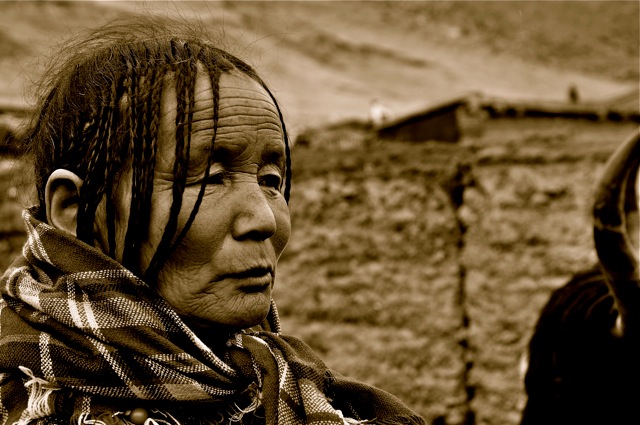
So often it is the elders who remember tales through their time spent recounting orally the comings and goings of the past. Here Amne Machin is a backdrop of life.
Breakfast often brings realizations – some stimulated by the first thoughts of the day and others brought to life from without. Tucking into bowl after bowl of milk tea this morning comes with a nugget of information imparted almost casually, which reminds me very clearly of what is key to this journey. It has to do with salt.
Muscle pain is thrown aside as this new tad of information settles in. We are nine people tucked into a square room no more than three metres square. Two beds, a wood stove, a makeshift altar and Michael and I trying unsuccessfully to shove our legs and filthy boots somewhere where we aren’t tripping people up.
My question comes amidst a full mouth of tea and tsampa (barley powder) and there are subsequent sprays of powdered barley as I bark out my query about salt.
“Was salt transported here by caravan”?
A middle-aged man with tawny eyes and large hands issues the answer and it is straightforward.
“Of course. Salt was always being moved around and there used to be a tsaka (place of salt) close to here”, he continues, “Traders often used these pilgrimage routes as trade routes”.
Somehow just hearing the words again, hearing this most informal of confirmations from a local lights up the morning. Within the landscapes that we have been traveling the land and elements have at times overshadowed the mineral itself. Here the daily doses of the spectacular overwhelm all, but suddenly and reassuringly the old salt routes come front and centre once again. Amne Machin is like a kind of skeleton that holds life all together.
The sky is grey and ambiguous as though pending. It is weather that is deceptively still and heavy and it is my least favourite weather system. I detest its heaviness. It feels tenuous like it cannot quite decide how to proceed and its quiet, windless heat plays with my brain and skin. I crave the winds, which I know are out there waiting somewhere just beyond this soupy grey. Snow fell last night and a bizarrely even snowline appears where the temperatures dropped below zero turning wet into white.

Dulse, harvested in the distant sea is crucial for us to maintain our sodium and potassium levels. I would boil it up and add it to our monotonous noodle feasts
Like many good-byes within the Himalayas, our own from this little home is disjointed, sudden and without any pomp. Gamzon, our guide is perky from her time with family and clearly energized. Terrier is his usual self, though slightly impatient to get on with it. I share his neurotic need to press on and get out of this warm valley, which is slowly strangling me. In the village we have picked up yet more noodles and some strange lumps of glutinous rice candy for the road.
We cut south down a valley that will take us to a divide with one route heading directly south and another cutting back west and then north. We will take the later cut-back, which will take us around the bulk of Amne Machin and hopefully to my old friend the wind.
Cutting in front of a homestead mid-morning we are forced into instant and unthinking action, with our entire team pressed into battle positions. Without warning a massive Tibetan mastiff comes at us dragging a chain, bearing teeth and looking the part of a guardian of the netherworld. Hackles raised, eyes blazing fury he has broken loose from that precious link that held him, and is upon us in a flash. Two slightly less ominous cronies of his, emboldened by their newly released mate’s display are following up on the flanks and in a moment it looks as if damage will be done to our caravan. Michael and I are both thirty yards ahead of the action and it is this that worries me most, that we cannot band together.
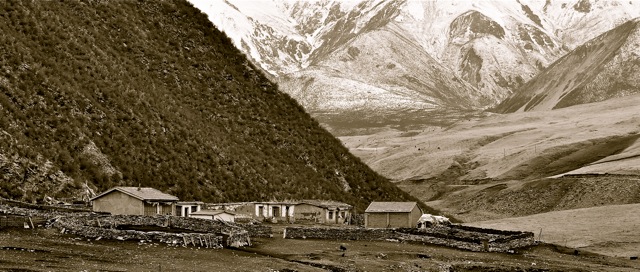
Scenes like this are more common within the folds of mountains – nomadic tents giving way to solid ‘winter’ structures
Michael and I have both taken to carrying flat headed rocks in our pockets for just such occasions, and quickly launch the equivalent of long-bow strikes…but these are too little and too late. The big beast (who looks to be about fifty kilos of rampaging murder) and his cohorts have moved in on our animals, but in a second I realize I have greatly underestimated our unit’s abilities in the blood arts. We are after all in the lands where all living beings are hard and toughened to such eventualities. Our guide Gamzon, on horseback, has instantly turned to face the threat and in doing so has urged our two brute yaks to do the same. The animals stay composed but I realize that our yak have dropped their heads and moved tight to one another forming a formidable phalanx. Their shaggy tails flit nervously – a sign that they are ‘excited’. No dog, however berserk or feral in these regions is unaware of the risk posed by an irate yak and being gored is not on any living thing’s menu plan. Our rampaging black attacker seems to realize the significant threat of yak, Tibetan iron-woman and raw-boned pony at in one moment and attempts to slow his momentum, skidding unceremoniously to a halt and ending up in a seething mess just outside of range of a yak horns. It is then that our own terrier (who has thus far been strangely invisible) moves in with the efficiency of small chainsaw, launching himself onto the exposed groin of the mastiff. His timing and aim are true as he sets about with ferocious efficiency nipping and snarling his way up and down the body of the bigger dog. It is a brutal and efficient display and there is a bit of sympathy in me for the poor mastiff. A moment later the mastiff is hightailing it home, stumbling and yelping, perhaps wondering where all of his bravado went wrong. His two comrades while initially game for battle had retreated earlier, clearly reading the signs of a prolonged and potentially disastrous campaign. Ripper shakes himself off and seems to be greatly enhanced by the activity. Tail held high he prances a bit, making sure to give Michael and I a look ensuring that we have appreciated the performance. I decide then and there that I have a slight crush on this small multi-talented canine. He is the complete partner on this journey – clever, vicious, entirely loyal, charming and understated. His engine seems incapable of breakdown no matter what the situation.
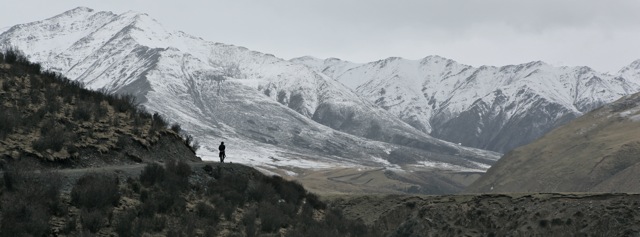
Our caravan and our own figures cut very solitary shapes in the huge expanses. Michael captures me ‘hunting for wind’
Our eventual veering right into another cavernous valley comes amidst still more heavy and almost suffocating air. Odd fence lines swerve and follow the contours of the land – strange to see these very ‘man’ oriented demarcation points. Nomads have long used (successfully) landmarks and informal systems by which to delineate ‘property’. In this remote corner it disconcerts to see these powerful landscapes parceled out into boxes. Amne Machin is no different. It is seen as a great marking upon the earth where deities reside.
It is a day of grinding, with little in the way of spectacles, though the morning’s canine scrap is still fresh in the mind providing me many smirks along the way. Michael wanders on his own taking in the valley and taking time to process. It is like this on intense journeys with bodies convening to share and then moving off again to be alone – it is in this way that the mind and psyche stay sane. I move on ahead searching out winds, silently hoping for their cold caresses to find us once again…and they do.
Funnelling into us, the winds arrive coming straight down from the mountains. There is snow too, mere bits of it at first, and the body instinctively draws comfort. Heat in the mountains for me is a hobgoblin that drains and saps me, creating a seething monster. The cold lights up the entire system giving the mind and body new energy and renewed hope.
In minutes snow is piling into us and I am back to my ‘regular’ self. High above our route, which has narrowed into a mere path, the hunched bodies of caterpillar fungus pickers stoop. A whole population of diligent workers tucked onto the mountainside will work in these extreme conditions for up to two months and will stay in camps that are themselves tucked away in these heights.
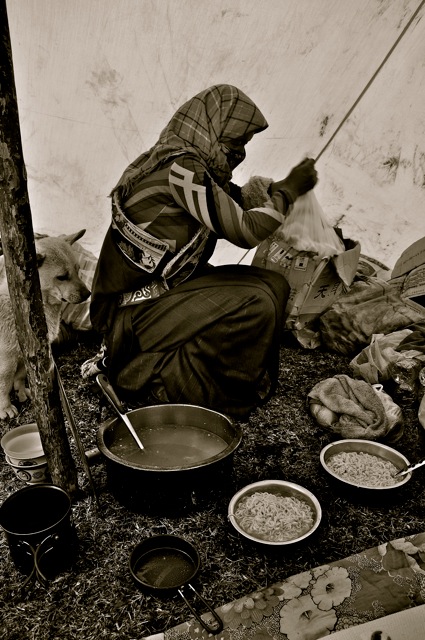
Tucked safely in our tent, Gamzon prepares yet another dinner of noodles. She is being carefully watched by our terrier (left) who keeps an eye on errant scraps. Here, his ‘look’ is far more revealing as to his true nature
Our camp rests above a valley and a cold that hits us in teeth moves in quickly. It hits -8 degrees Celsius and for the first time I actively welcome our miniature body guard into the covers for a well deserved rest. Amne Machin is the conductor weather…at least that is how I play it in my head.
We awake with a shudder to mountain cold and the realization that something has changed overnight regarding our ‘team’. Clear air with a hint of blue in the sky as dawn gives way to day waits…. while by the fire a strange figure coaxes more heat from the coals. Our canine friend is stretching out his little limbs to rid them of cold. The larger mastiffs have all disappeared – home I guess. It is the figure near the fire that holds me as I emerge from our tent. Where is our guide Neema?
The figure, however, is clearly not that of our guide Neema, but rather his wife whom we had met upon our arrival to Xiadawu. An ‘exchange of bodies’ has taken place in the night. Little Neema has left in the dead of night and in return his sturdy, bullet-proof wife and her pink turban have arrived.
She explains in a soft voice with the requisite hand signs that Neema the previous day had succumbed to chills, headaches and fever as the cold had been too much for him and as the day and night wore on. He had found enough phone coverage to convey the need for a substitution, so here we were. As she speaks there is the slightest smile around her eyes of apology, as though she has long been aware of his susceptibility to the cold. Looking at her wrapped in her wools with one arm free I suspect that she suffers no such issues.
Michael and I react with shrugs and a bit of disbelief that Neema’s constitution could not hold up. The deep cold that we have encountered thus far, while not extreme, is unseasonal and the fresh snow hints that winter is not yet done with its sermon. Perhaps it is better that this happen now rather than later on.
Moving on from camp each individual body of our group spreads out in a staggered line as we ascend from over four thousand metres ever higher. The snow is deep and heavy and the light in the sky seems content to hang behind a body of low lying cloud. Snow from the sky feels imminent and I am thankful for the litre of bitter tea that now streams through my body warming limbs and insides.
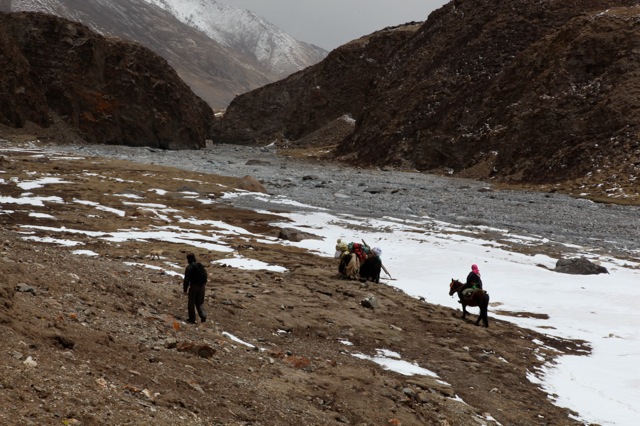
Our caravan making its way east using the valley as an informal route. Valleys weave through a feats of Mountain shapes
No bodies appear on the horizon, no migrating nomads and no mythic trade caravans, we are utterly and happily alone. It is too early in the season and there is a feeling that our little group is at one with the elements. As time passes I note with a satisfaction that our present guide, Gamzon, is managing the yak with a gentle precision that her husband lacked. The animals respond to her competence and sanity with more kinship than they did to Neema’s slightly jittery personality. This coupled with the fact that she strapped our tent and gear to the yak’s backs in half the time it took Neema suggests to me that this has been good fortune to have her taking over.
Winds whip up, ice pellets drive into us and the sun plays peek-aboo as we ascend the 4,600 metre Darde Lhatso pass. Mountains are in the foreground, the background and the sky.
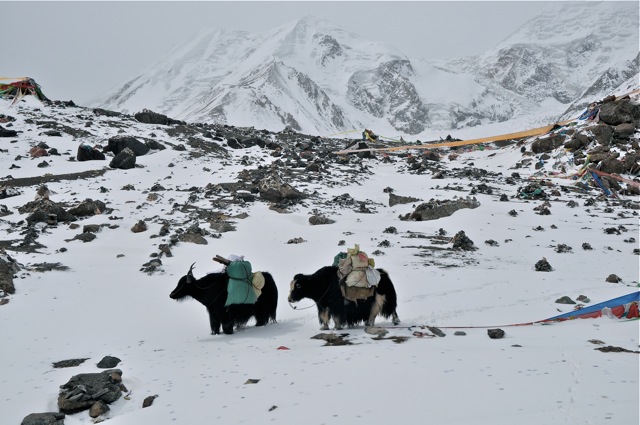
Our faithful yak atop Darde Lhatso pass, pause as if to pay homage for their (and our) safe passage. Mountains of the main Amne Machin range sit in the background.
Atop the winds howl and we are gifted a view of the greater Amne Machin range. It appears as a violent white canvas that has been cut with a stained knife. Winds obscure the entire sky but there are brief peaks of a brooding mass rising up above us.
Prayer flags whip about in gusts. Below us an entire landscape of glaciers line the valley floor. The look ancient and powerful and utterly patient. Once they ruled here cutting up landscapes in slow unstoppable movements. Now only their icy bodies and scars remain.
Our gradual descent from the wind bludgeoned pass is met with sun and with its arrival the world changes. Heat powers into the shoulders, snow melts into rivulets and a space of Amne Machin’s great white length opens up before us. The Mountains here instruct and the locals have long followed valleys and passes through the spine of the ridge lines.
A primordial valley lies heading east stretching into a distant black horizon of stone. Here, for the first time we are offered a scale of the mountains and I feel this mountain’s character start to emerge for the first time. It is a massive corridor running a deceptively long way with shoots and carved troughs emptying its melt water into cavernous valleys. No longer does the mountain brood.
Caravans carrying goods would have passed this way later in the season when they were still active, as will nomadic communities on the move in a week or so. Summer grazing awaits higher on the mountain.
Gamzon our guide, and our faithful yak are slow but unrelenting in their pace – tonight they will need to access grazing lands to feed tonight. Passing over ice-cold torrential rivers our yak’s eternal appeal is their unremitting pace and sureness of foot. They do not hesitate, finding secure footing on every surface, at times showing nimbleness and lightness of touch that is ‘almost’ (but not quite) elegant.
Michael and I must also find ways to launch ourselves over these rushing onslaughts of water, at times making it by mere centimetres…and in a case or two ‘not’ making it by centimeters.
Lunch consists of some muffins, an apple, half a flask of tea and a couple of leaves of dried seaweed that I have brought – something of the sea loaded with potassium, sodium and iodine – to provide precisely what I am burning at these altitudes. Mountains bring their own stresses and warnings, but they shelter as well.
Eventually the snow carpets that we have tread on for days are no longer. Descending onto dried turf and rock basins, yak herds spot the slopes and even a forlorn tent or two become visible. We have moved from one realm to another.
We are offered the option of staying either in a camp or traveling another three hours to our guide’s mother’s home. A smile is passed between Michael and I and it is quickly decided to continue on to “mother’s” village. While some of the delicate and brutal beauty might be missed, live bodies and the warmth of people (and fire) are always welcome.

Gamzon and the yak negotiate safe passage through a river. Though sure-footed, our yak seemed to be aware that one miss-step could mean bad news in an instant.
At this juncture there lies an enormous valley that cuts directly into the main range to our right but we will not take it, instead pushing one further east – we are approaching the 30 kilometre mark – all of which has been above 3,700 metres – we will easily do over 30 kilometres today. The teasing promise of a warm bed and warm water can fuel the will like few things in the mountain.
For Gamzon our guide, who has been quietly titanic this day it will also provide her a chance to see her mother and grandmother – a rare treat in these desolate lands.
The town that we eventually arrive to seems a confused collection of huts randomly put up in the crucible of three valleys that meet. Nomads, fungus pickers and some random workmen erecting a structure add to the melee of bodies here.
Gamzon’s mother, a tiny woman with a huge smile and pleated hair, comes out to us shuffling along in a thick collection of robes. Grabbing the yak she takes them and our chestnut mare to a corral and us to a collection of small huts.
Gamzon is twice the size of her youthful mother, and when her grandmother appears I marvel. Each woman shares almost no similarity with eachother. The grandmother seems immortal with luminescent beauty and a vitality that is stunning. Her missing teeth, strangely enough do nothing to diminish her beauty and her laugh is a universal sort to stir up the soul.
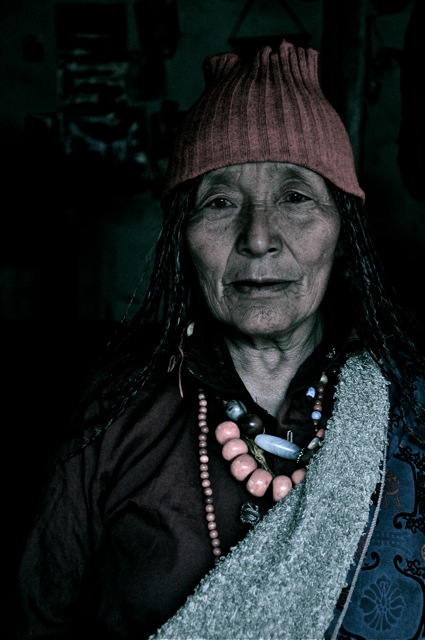
A face and presence that stops all thought dead. Gamzon’s grandmother’s sage-like demeanor was interrupted only by explosive bursts of deep laughter and mirth making her an instant favourite.
We are bid welcome by a collection of relatives to sit in a cosy little room. Mountains though, even in shelters are never forgotten. They loom as much in the mind as in the backdrop. All that is their’s is offered up in the way that the truly generous do. A huge woodstove dominates the area and soothes the bones. Beside an ageing grandfather’s bed sits. Common space to Tibetans is the only space (besides the prayer room) that really matters.
Gamzon and her mother sleep together across the room from us chatting long into the night. The chirps, tweets and tones of happy gossip and catching up bid us farewell, and welcome us into the world of vivid mountain dreams.